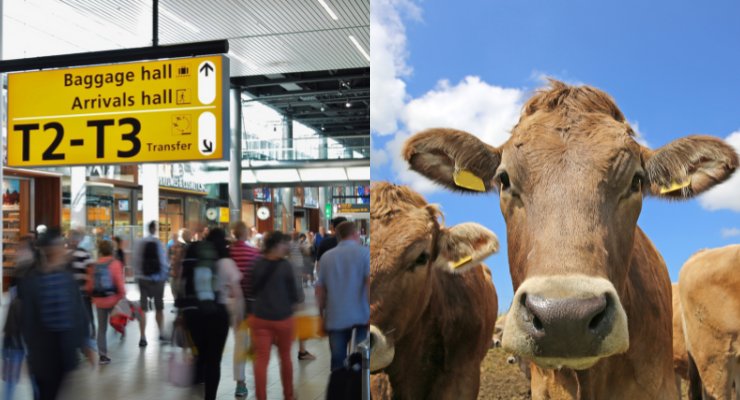
Viral fragments of foot and mouth disease have been found in an undeclared beef product detected at an Australian airport. The undeclared beef was carried by a passenger coming from Indonesia. Additionally, authorities have discovered viral fragments of the disease as well as African swine fever in pork products in Melbourne’s CBD during “routine retail surveillance”.
Agriculture Minister Murray Watt says that, despite these fragments being found, Australia still remains free of foot and mouth disease, the highly contagious virus that could cause $80 billion in damage to Australia’s economy if an outbreak were to occur. The fragments found were not live and cannot transmit the disease.
Additional biosecurity measures will be put in place in Australian airports. As ABC reports, international arrivals will use foot mats to clean their shoes, which are doused in citric acid to deter the virus. The acid is not harmful to human skin.
Australians returning from Bali to be on extra alert
Thousands of Australian holidaymakers are returning from their winter vacation in Bali and are being warned that, with foot and mouth disease spreading through Indonesia, they could be carrying a devastating disease time bomb on their feet or in their backpacks.
Foot and mouth disease was detected in Bali last month, travelling from neighbouring island Java, and experts are warning that one dirty pair of thongs could shut down Australia’s $27 billion livestock export trade for months, decimating the industry.
For Australians returning from Bali or elsewhere in Indonesia, here’s what you need to know about the deadly disease to help keep Australia’s borders safe.
What is foot and mouth disease?
Foot and mouth disease is one of the most serious livestock diseases out there. It’s a highly contagious virus that affects cloven-hoofed animals — that is, animals with feet divided into two parts, so cows, buffalo, camels, sheep, goats and pigs. Horses are not affected by the virus.
The virus presents as blisters around the mouth and hoofs of the infected animals that turn into painful ulcers that ultimately stop the animals from walking and eating. It is incredibly contagious — about as contagious as the COVID-19 Omicron variant, according to Professor Michael Ward — and in most cases, the whole flock will catch it.
The disease has a very low mortality rate but a very high economic impact, as the only way to control it from spreading is through culling and vaccination (a difficult process as there are numerous strains of and numerous species susceptible to the virus).
Can foot and mouth disease affect humans?
Unlike hand foot and mouth disease that affects humans, particularly children, foot and mouth disease is not a problem for humans. Human infections are incredibly rare and do not result in serious disease. We can, however, carry it on our shoes and clothes or even up our noses.
Why are we so worried about bringing it to Australia?
Australia is historically free of foot and mouth disease, but you might remember the outbreak in the United Kingdom in 2001 that caused a crisis in British agriculture and tourism, costing the UK an estimated £8bn (approximately A$15 billion) and involved the culling of approximately 6.5 million animals.
If foot and mouth disease is found in Australia, we would be cut off from the export market, which makes up about 70% of Australia’s meat trade. If the disease does reach our shores, the estimated cost is about $80 billion.
On top of this, having never dealt with our own outbreak before, it’s hard to know how quickly we could eradicate the virus. Vaccines can assist with eradicating the disease within livestock, but due to a large amount of variations, it can be incredibly difficult to control via vaccines. On top of this, the disease could easily get into Australia’s feral animal population, which would be incredibly difficult to control.
How to prevent bringing back the disease from Bali
The virus can last up to 24 hours on shoes, clothes, and even up your nose, which, given a flight from Bali to Australia is only between two and a half to seven hours, is more than long enough. Holidaymakers could easily pick up the virus on their clothes or shoes by visiting farms, petting buffalos or pigs in markets or fields, or even just by walking around temple grounds, the road or the sidewalk.
According to Nine News, the Australian Border Force has confirmed that more than 128,000 Australian passport holders travelled to Bali in June. It only takes one case to decimate the industry.
The best way to avoid bringing the disease back to Australian shores is to steer clear of animals on your trip. However, you can’t know what cloven-hoofed beast has walked the streets before you, so experts are also suggesting that you ditch your footwear on the island.
Yet, throw out those thongs (it’s winter here, anyway) and make sure you declare any other shoes you have tucked away in your suitcase so they can be assessed.
Upon arrival in Australia, passengers should closely follow new and existing biosecurity orders — this is always a given, but make sure to err on the side of caution. Alert officers to anything that may have come into contact with an animal and don’t be precious about your luggage. There’s a lot at stake right now when just one wayward thong could wreak havoc on Australia’s agriculture industry.








Why not stop all unnecessary travel to infected countries until the risk is neglible? There are planty of locations in Australia suited for a vacation. Our frenzied need for global travel not only imports all manner of human disease, and is now threatening livestock and more livelihoods. If needed, make a financial donation to the Balinese for the lost custom. As great deal cheaper than importing this Enterovirus to add to the woes being inflicted by Coronavirus.
Expecting ALL travellers to actually do something to assist with biosecurity is rediculous – as we saw with Covid vaccinations, there will be at least 10% of people who won’t bother (i.e. don’t see it as their problem) or will simply forget. Biosecurity measures will have to be undertaken by the government and will need to be well resourced and invasive (e.g. checking of suit cases and treatment of footwear). The question is, are we really serious about it? For an $80 billion dollar industry, I would have thought we should be….
Clearly need supervision of all travellers disembarking from Bali,to go through foot bath asking isn’t going to work .
Either stop travel to/from Bali or quarantine anyone who has been in Bali.
I have to wonder whether David Littleproud (possibly for the first time in his life) might have half a point. In some native forest areas you have to take footbaths in case you spread fungi or parasites though endangered vegetation. And if someone’s wearing thongs (the foot variety), have a bin nearby so they can get tossed out. Foot and mouth is too big a risk not to take as many logical precautions as possible.
WTF? I wrote this comment last week. Interesting to see that Littleproud is now muttering dark things about the footbaths now being unnecessary.
Do pig shooters go to Bali? FMD will get here, and will spread to feral pigs (It may even start there). Would it not be a good idea to attempt to eradicate feral pigs now? They already do untold damage to farms and the bush, so the attempt would be money well spent, regardless. Eradicating FMD in any part of Australia is futile until the ferals are wiped out.
And do the camels here get FMD? They hang around cattle stations (and can carry most things!).
Sadly, I don’t think there’s ever been an invasive species ever removed from Australia. I’m the first to back the idea of eradicating pigs (along with goats, buffalo and sadly, horses), but you’ve got to hunt the pigs through thick, often spikey brush with dogs, and it’s slow, time intensive work. And a good breeding season can undo in a couple of months any losses caused by hunting over an entire year.
If we’ve learned anything over the last few decades it’s that the only way we can wipe out an animal species is through negligence. Trying to do it deliberately doesn’t work